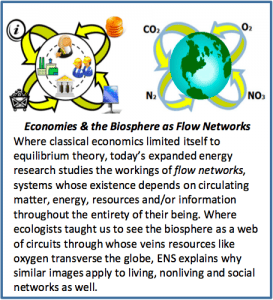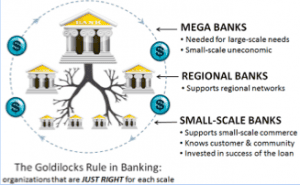
We are pleased to introduce this week’s guest blogger, Dr. Sally Goerner, who is joining Capital Institute as a Science Advisor.
There is an epidemic failure within the game to understand what is really going on. And this leads those who run major league teams to misjudge their players and mismanage their teams… Baseball thinking is medieval. They are asking all the wrong questions.
People see this new way of thinking as a threat, and not just to a way of doing business, but, in their minds, it’s a threat to the game itself…
But anybody who is not tearing their team down right now and rebuilding it using your model − they’re dinosaurs.
– Dialog from the movie Moneyball
In the movie Moneyball, a new scientific model shows how to reinvent baseball, allowing the Red Sox to overcome the curse of the Bambino and win the pennant for the first time in 86 years.
Today, a new scientific model – in this case a more rigorous stage of systems science based on the study of energy-flow networks – can show us how to reinvent the game of capitalism in a way that revitalizes the whole system, bottom to top.
Instead of loose analogies to ecological concepts, this new model provides the predictive theory and precise measures today’s social entrepreneurs and policymakers need to diagnose problems, identify cures, integrate efforts, guide policy, and assess systemic health. Here, the storyline of Moneyball applies as much to the games of economics and finance as it does to baseball:
A number of thought leaders and entrepreneurs are seeking to reinvent capitalism because it isn’t working for large segments of the system. In our terms, their goal is to create a regenerative form of capitalism that produces lasting social and economic vitality for global civilization as a whole.
A more rigorous stage of Systems Science can show us how to turn today’s lopsided capitalism into vibrant regenerative economies. Whether it is called complexity, systems or networks, improved insights into our interdependent world are coming from the study of whole systems, the dynamic relationships that bind them, and the conditions under which they thrive. Today, discoveries of how energy drives development are merging with ancient understandings of nature’s designs to produce a rigorous understanding of systemic health and development that applies to living, non-living, and social systems including economies.
The future will belong to those who have the vision to use this scientific model to build a better world − and who have the chops to make this regenerative reformation happen.
I call this work Energy Network Science (ENS) because it uses energy networks and nature’s designs to illuminate universal laws and optimal patterns of health and development.
Energy fuels organization, drives development, and creates pressure for change. Because such principles are universal, they help explain why similar laws apply to systems as diverse as living organisms, ecosystems, and economies. Because they are empirical, they explain why rigorous findings apply across this range as well. Already well-known in ecology and living systems, the result is measurable laws of health and development that work in economies.
Easy to see and measure, ENS’ patterns focus our economic efforts on making human networks healthy, as well as on making money.
Because ENS is about networks, its big realization is that the only way to build a vibrant economy is to build healthy human networks. Because it values human networks, it brings a new vision of the relationships and values needed to build vibrant economies. Because it is a (relatively) exact science, it provides a solid foundation for a regenerative economy and the measurement tools we need to build it.
The result enhances New Economy efforts by:
✓ Identifying the optimal network structures, right relationships and peak patterns of development that the cosmos uses to build healthy, self-sustaining, learning systems;
✓ Showing the logical connection between whole-system dynamics and the boom-bust cycles seen in human systems, thus providing effective diagnoses of their causes and cures;
✓ Providing rigorous measures of systemic health that support practical applications;
✓ Validating the dream of free-enterprise democracy and showing us how to achieve it.
The following examples provide a taste of ENS’ potential.
Poor circulation creates economic necrosis: The fact that robust, cross-scale circulation is essential to systemic health explains why poor monetary circulation to lower levels of an economy − low wages, few small-scale commercial loans, etc. − results in economic necrosis, the dying off of large swaths of economic tissue. Quantitative measures of internal circulation (such as multiplier effects) help assess systemic health and give teeth to the truism: “beggar-thy-neighbor policies come back to haunt.”
Fractals as optimal designs & measurable targets: Scientists since the ancient Greeks have studied the universal patterns that fill our world. Today most researchers believe such patterns exist because they support some aspect of systemic health. Lungs, for instance, have a branching structure ─ with a few, highly-efficient, big conduits on top and successively more numerous, less efficient, smaller conduits on the bottom ─ because this particular structure optimizes the diffusion of oxygen into the bloodstream. Nowadays we call this pattern a fractal and use new mathematical methods to measure them precisely. Because fractal patterns help optimize many forms of function and flow, they are found in everything from leaves to river deltas.
We can use fractal balance to:
- Quantify the observation that “too big to fail” is deadly and a shrinking middle-class indicates ill health;
- Confirm that sustainable prosperity is an integrated, cross-scale affair requiring proper balance of localism, globalism and all points in between;

*****
We experience outsourced jobs and decrepit schools as local events, but underneath we know they are symptoms of global economic dysfunction. ENS can provide the tools we need to turn dysfunction into regenerative vitality. Stay tuned for more details.

Nikos Salingaros (Google “Fractal Cities”) shows that a proper balance of pathways helps catalyze critical city functions at each scale – e.g., footpaths support neighborhood conversations and highways support rapid transit. Supporting the full gamut of processes increases innovation, empowerment and community cohesion.

